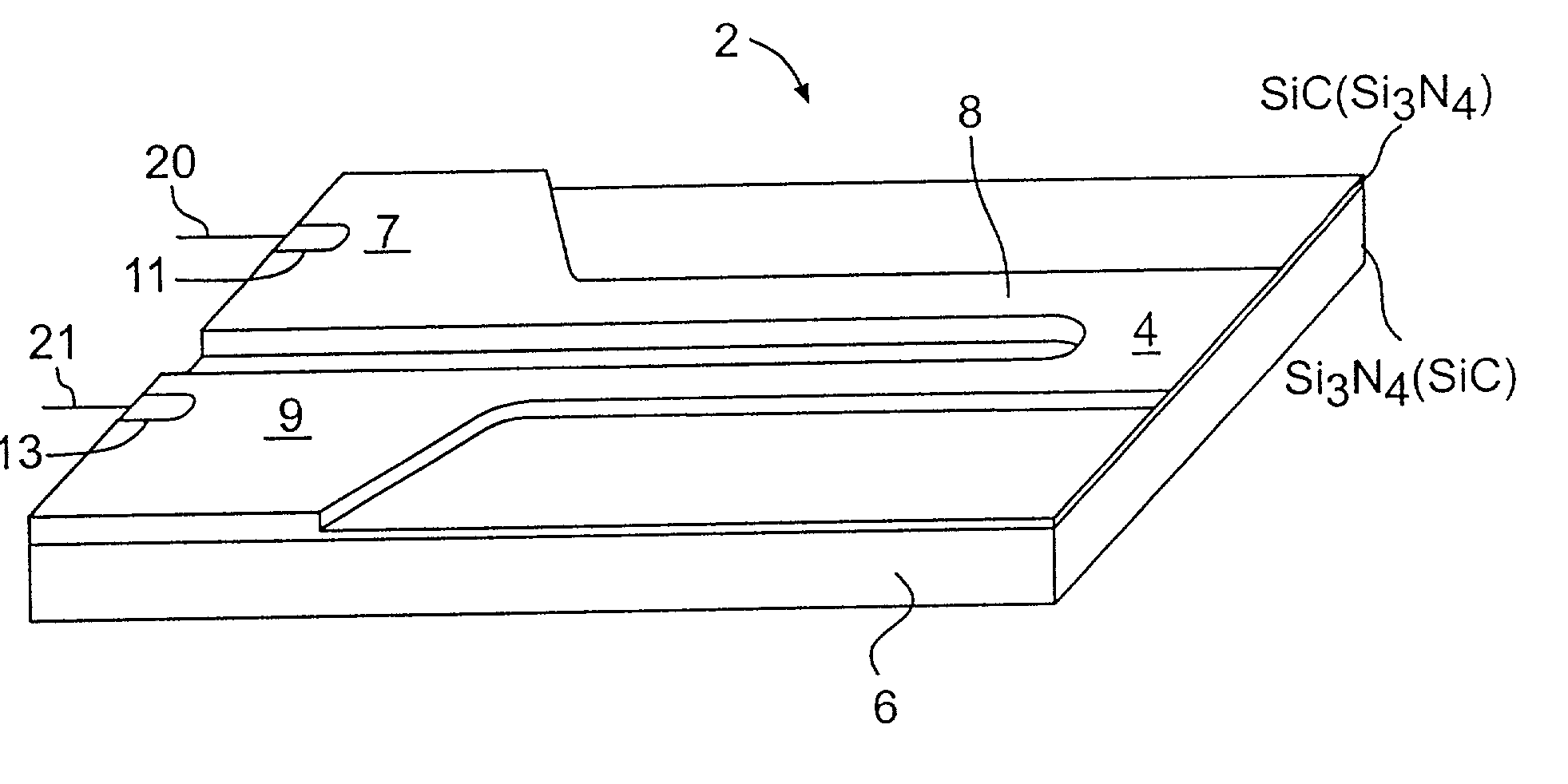Composite monolithic elements and methods for making such elements
a monolithic element and composite technology, applied in the field of composite monolithic elements and methods for making such elements, can solve the problems of low yield in the manufacturing process, relative fragility, and high cost of igniters
- Summary
- Abstract
- Description
- Claims
- Application Information
AI Technical Summary
Benefits of technology
Problems solved by technology
Method used
Image
Examples
first embodiment
[0026] A composite monolithic heating element or igniter 2 in accordance with the invention is shown in FIG. 3. As illustrated, the igniter 2 includes a first region or layer 4 which has a first specific property. For example, in this embodiment of the invention, the first region or layer 4 act as a conductor or hot portion of the igniter 2. The igniter 2 also includes a second region or layer 6 which has a second specific property which is different than the specific property of the first layer 4. For example, the second layer 6 may act as an insulator and at the same time provides a physical support for the conductive layer 4.
[0027] An important feature of the present invention resides in the bonding together of the first and second layers 4 and 6 with a joint free bond to thereby form a mechanically continuous structure. This formation of a joint free mechanically continuous structure allows for the use of an extremely thin conductive layer 4. This feature i.e. the relatively thi...
example 1
[0045]
1 80 v / a SiC-20 v / o Si.sub.3N.sub.4 (Low Pressure Ejection Molding) Silicon Carbide (Green) FF Size 592.8 grams 1200 Grit 441.0 1600 Grit 114.0 LS-13 49.2 UF-10 84.7 UF-15 231.0 UF-25 16.7 UF-45 15.8 Total SiC 1545 Grams Si.sub.3N.sub.4 - 325 295 grams Organics Paraffin Waxes 217.5 Grams Montan Wax 3.3 Grams Surfactants / Modifier Ethylene vinyl acetate 4.4 Exxon Vistanex 5.1 Steric Acid Diethanolamicle 2.6 Oleic Acid 7.8 Chevron Oloa 1200 9.4 Polyueric Fatty Ester 2.2 Lecithin 5.9 N-Tallow 1,3 Propanedianine 2.5 Petroleum Distillate (SAE-10) 4.2 Amorphous Carbon (Calcined Petroleum Coke) 336 Grams 80 v / o Si.sub.3N.sub.4 - 20 v / o SiC (Insulator) LPEM Mix Silicon Metal - 44 Micron 670 grams - 10 Micron 390 grams Silicon Carbide (-325 mesh) 416 grams Organics Paraffin Waxes 202.5 Surfactants / Modifiers Ethylene Vinyl Acetate 4.2 Exxon Vistanex 4.9 Kantstick Z 7.3 Montan Wax 5.4 Steric Acid Diethanolanide 5.0 Oleric Acid 5.9 Steric Acid 1.5 Polymeric Fatty Ester 4.1
[0046] A process ...
PUM
| Property | Measurement | Unit |
|---|---|---|
| temperature | aaaaa | aaaaa |
| aspect ratio | aaaaa | aaaaa |
| temperature | aaaaa | aaaaa |
Abstract
Description
Claims
Application Information
 Login to View More
Login to View More - R&D
- Intellectual Property
- Life Sciences
- Materials
- Tech Scout
- Unparalleled Data Quality
- Higher Quality Content
- 60% Fewer Hallucinations
Browse by: Latest US Patents, China's latest patents, Technical Efficacy Thesaurus, Application Domain, Technology Topic, Popular Technical Reports.
© 2025 PatSnap. All rights reserved.Legal|Privacy policy|Modern Slavery Act Transparency Statement|Sitemap|About US| Contact US: help@patsnap.com



